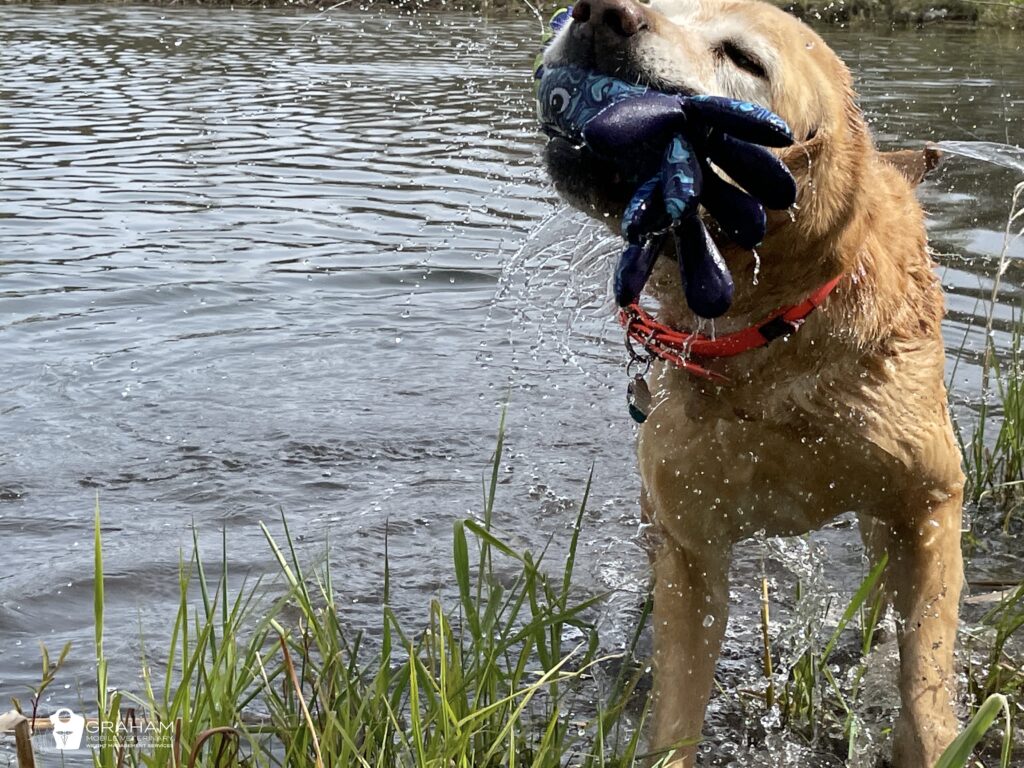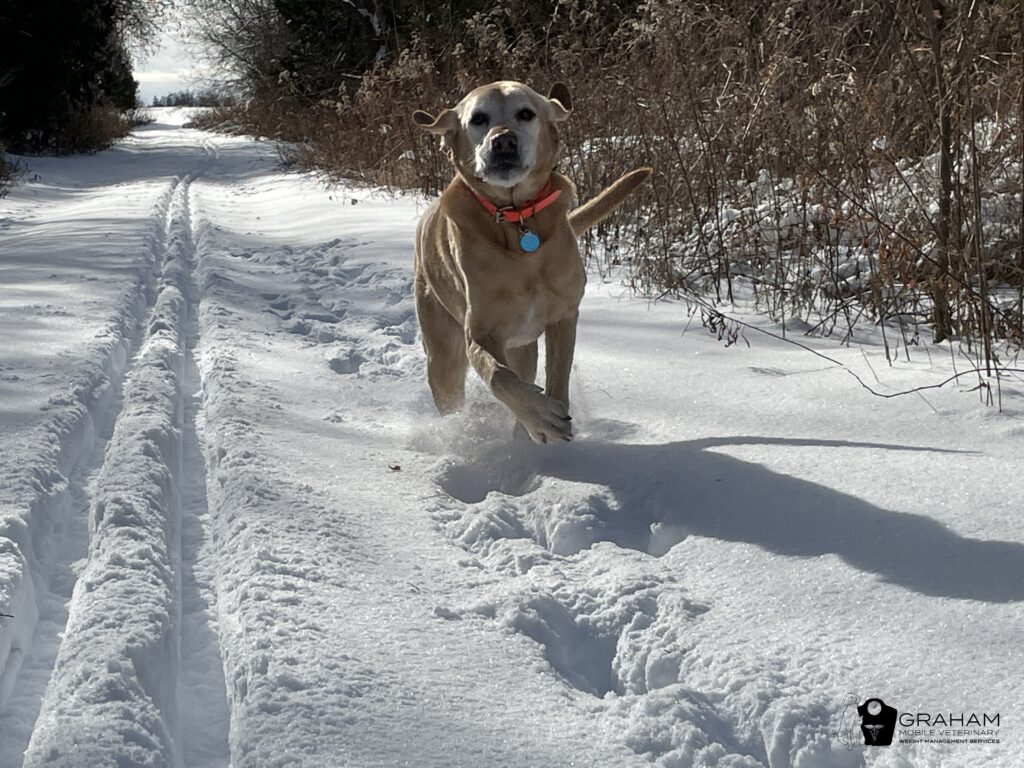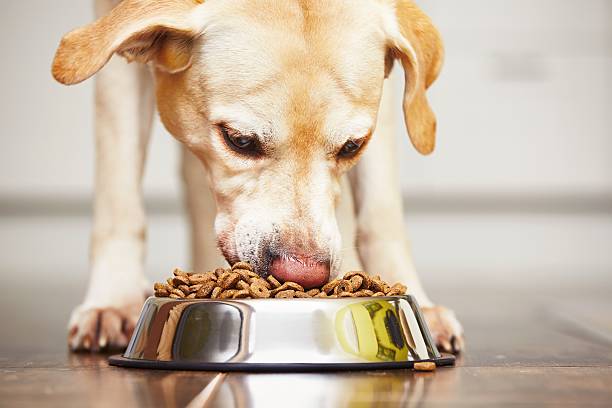By Kirsten Graham DVM
An Ounce of Prevention is Worth a Pound of Cure
Benjamin Franklin’s famous quote, “An ounce of prevention is worth a pound of cure”, could not be more on point when it comes to the topic of weight management. While 60% of dogs are overweight or obese, your Adventure Dog is unlikely to be a contributor to that statistic. The goal is to keep it that way. Read on for our top five tips on maintaining your Adventure Dog’s healthy weight!

1. Don’t put too much weight on the number on the scale
Your dog’s weight doesn’t really matter – kind of. The number on the scale is mostly useful for monitoring purposes like identifying subtle changes in your dog’s weight over time and not as useful as a stand-alone piece of information. What’s most important is their body condition – how your Adventure Dog carries that weight on their frame.
Standing squarely on all four feet, a dog in ideal body condition should have an hourglass-shaped waistline when viewed from the top and a distinct abdominal tuck when viewed from the side. Additionally, your dog’s ribs should be easily felt when running your hands over their chest, similar to what the bones in the back of your hand feel like when you make a fist. If your dog’s chest feels more like the knuckles of your fist – or if you can stand back and count your dog’s ribs – they may be too thin; by contrast, if their chest feels like the palm of your open hand – or worse, like the heel of your hand – they may be overweight. Check with your veterinary care team for their opinion on your dog’s body condition and if it isn’t ideal, ask them for help in getting your pet to a healthier weight.
2. Crunch the numbers to determine caloric needs
Just like people, every dog has a unique metabolism and knowing your Adventure Dog’s specific caloric needs is key to maintaining their healthy weight. There are various mathematical equations that can be used to get an estimate of a dog’s caloric needs and these provide a good starting point but usually need to be tweaked to account for each dog’s individual requirements.
Start by providing your veterinary care team with a detailed Nutritional History which involves documenting every single food product your dog eats – think everything that crosses your dog’s lips except for water – and including the quantity and frequency the item is fed. Specific details like brand, flavour, and size are imperative for this to be done accurately and it’s immensely helpful if you can provide photographs of the packaging or website links for each food item.
From that information, your dog’s current total daily caloric intake can be calculated. If your dog’s weight and body condition have been maintained well and consistently at this caloric intake, we can then deduce that this is your dog’s magic number to meet their daily caloric needs.
3. Zero in on precise feeding
Now that you have a good handle on your Adventure Dog’s daily caloric needs, you want to be sure to feed them precisely. Although commonly used, measuring cups have been shown to be surprisingly inaccurate for portioning pet food, resulting in inadvertent overfeeding which adds up over time.
Enter the digital kitchen scale. This inexpensive device will allow you to feed your dog as accurately as possible, ensuring they receive exactly the right number of calories to maintain their healthy weight. Not only that, weighing the food will save you money – since you won’t be overfeeding – and will allow you to predict exactly how many days your supply of food will last – so you can avoid running out of food at the most inconvenient of times.

To keep things as simple as possible, weigh your dog’s total daily food allotment into a clean container and feed only from that container throughout the day. To make life even easier, containers can be obtained for the seven days of the week allowing for just a once-weekly date with the digital kitchen scale. Check out our blog, The Scoop on Portion Control, for all the deets!
4. Treat them right
A dog’s core diet must be nutritionally complete and balanced – containing all the key nutrients required to sustain life – for the animal to remain healthy; all other consumed products are considered treats. With that in mind, treats should make up no more than one tenth of the dog’s total daily caloric intake – in other words, your Adventure Dog may have a 10% Treat Allowance with the remaining 90% of their daily calories coming from their core diet.

To factor in treats, the item’s caloric content must be readily available and ideally each piece of a given product should be the same size (or easily weighed with your brand-new digital kitchen scale!) so that the calories received from each treat is consistent.
Obviously, treats that are high in calories will need to be avoided, especially if they exceed the 10% Treat Allowance. A stroll through the pet store or even a peek in your cupboard can be quite eye-opening and certainly provides some food for thought – pun intended. For the complete low-down on treats, visit our Cookie Monsters blog series!
5. Monitor, monitor, monitor
The final piece of the puzzle is to keep a close eye on your Adventure Dog’s weight and body condition regularly – this is where the number on the scale does matter. Caloric needs may fluctuate with activity level, age, reproductive status, or even seasonally and feeding amounts should be adjusted accordingly to maintain a healthy weight.
Any time a change is made to your dog’s diet, whether it be to quantities offered or to specific foods being fed, their weight should be monitored closely – every two weeks, ideally – for a few months to make sure that the adjustment achieves the desired results.
Once you are confident that your dog’s weight is stable and their body condition is ideal, weight checks can be stretched out to every six to eight weeks. The simplest way to do this is to pay regular visits to your friendly neighbourhood veterinary team for a weigh-in where you can also get a professional opinion on your dog’s body condition.
Alternatively, you can invest in a digital small-animal platform scale to monitor their weight at home. Bathroom scales should be used with caution as there are risks to your dog – being accidentally dropped – and to yourself – lifting your dog or even being bitten, if your dog is fearful – and their accuracy may be questionable, especially for smaller animals.

Keeping your Adventure Dog in tip-top shape is crucial to their health and safety as well as to their quality of life. If you are concerned that your dog may be over- or underweight, seek the guidance of your veterinary healthcare team; even at a healthy weight, regular health checks are a must for dogs participating in extreme sports. Happy trails and happy tails!
Additional resources
- Graham Mobile Weight Management Services
- The Healthier Pet Within blog
- AAFCO Guide to Reading Pet Food Labels
- WSAVA Nutrition Toolkit
About the author
Dr. Kirsten Graham founded Graham Mobile Veterinary Weight Management Services in 2021, the first practice of its kind dedicated exclusively to the treatment and prevention of obesity in dogs and cats. Through house call and telemedicine services, Dr. Graham helps pets throughout Ontario achieve a healthier weight, ultimately improving their quality of life. Visit www.thehealthierpetwithin.ca or follow @thehealthierpetwithin on Facebook and Instagram to see what Graham Mobile Veterinary Weight Management Services is all about!
Related Dogpacking.com reading
The Health & Safety Concerns of Raw Dog Food & Raw Dog Treats




Leave a Reply